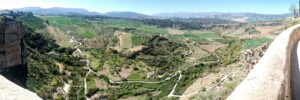Winding through the mountains of Andalusia, passing miles and miles of olive groves, small villages, and peaks, our excitement approaching Ronda grew each minute. Maite in Malaga told us we really ought to consider rearranging our schedule and spending a couple of days in Ronda. She was right about every recommendation thus far, so we made it happen and were excited to get there. The online pictures were amazing, and we were excited to get there in person.
The bus station is not far from the geographic center of town, up the hill. Walking to our B&B afforded a chance to stretch our legs and see the town since the rooms were on the south cliffs of the city. You can read all about the city being built on high bluffs and look at pictures of the bridges. They’re great. Walking across those bridges and standing on the bluffs are totally different. Dang, Maite, you nailed it!
Ronda dates back to the 6th century BC and was named a Roman City (that meant something) under Julius Caesar. Captured by the Visigoths from the Romans, Ronda fell to the Muslim armies in 713. It was at times its own tiny independent kingdom and at others a provincial city of larger kingdoms. In 1485, Ronda was liberated by Rodrigo Ponce de Leon at which time its Muslim heritage was slowly Christianized along with the rest of Spain.
As a hilltop town, it must have been an impressive fortress, one which defenders loved and must have dispirited attackers simply looking at it. With impressive, thick walls at the base and steep cliffs, it is little wonder Ronda remains in such fine condition to this day. Walking from the bus station to the B&B requires crossing the most striking feature in the town, the Puente Nuevo, or New Bridge, which spans the narrow and deep chasm in the center of town. Built between 1751 and 1793, the bridge connects the old town to the south with the old town to the north of the chasm. Tourists stroll and wait to get the best pictures. Cars and buses patiently wait for pedestrians to get out of the way, and many people just lean on the old wide railings and stare in wonder.
The views from the Museum House of St John Bosco (for decades a retreat house and old age home for Salesian priests) are magnificent as are the views looking up from the trail and waterfall below the bridge. It is difficult to explain to someone who has not been there how many unique views of the cliffs from below are possible as well as of the town and surrounding valleys from above.
On the north side of the bride sits the Ronda Bullring, the oldest bullfighting ring in all of Spain. It is both a functioning bullring which hosts the annual bullfight circuit, and is a museum of bullfighting and martial skills. Royal military officers were sent to Ronda to train in horsemanship, sword skills and tactics. Bullfighting initially was a form of training for officers before becoming a specialty in its own right. Walking through the bullring and museum is a wonder. Seeing the deeply worn wooden benches, the maze of chutes and holding pens and gates for the bulls, the clay of the bullring itself, really makes you feel excited even when there is no bullfight.
Ronda affords the visitor few broad avenues. Mainly narrow streets and winding passageways. You can climb up and down trails and staircases, visit the 500 year old churches, some of which were mosques for 500 years before that. Climb the church steeples and find a completely new perspective, one that looks down on the rooftops. Walking down to the Baños Arabe (Arabic Baths) below the town and back up to the town is strenuous, but not hard. It feels right and helps with the appetite for a good meal.
After walking through the town, there is the magic of sitting on the patio of Lars and Jenny, our B&B hosts, overlooking the valley and to the mountains. Lars is from Denmark, Jenny from Malaysia, and no finer hosts can you find in Spain. Their quiet place has 3 guest rooms and their own small apartment with a beautiful outside terrace on the cliff of the old town. Below you in the evenings a very weathered, very old man herds his sheep out into the little vale. He uses his staff to whack the climbing vines out of the trees. He lays in the shade. He talks to his sheep. He does not have a cell phone. He is content. Would that we all were as he is.
As my friend and fellow Cultural Debris Excursion leader, Alan Cornett says, we ought to strive to be visitors, not tourists. I was surprised by the number of people we saw in Ronda that were passing through just to take some pictures and move on, or at most, spend one night. Seeing a tour group of 30 people in a line behind and umbrella-toting guide on a narrow side street made me glad for our small Cultural Debris Excursion groups of 6 guests. The big groups couldn’t fit in the little nook and fountain to admire the fig tree growing out of a wall.
Ronda is the kind of place where I could easily spend several days just relaxing, talking with Lars and Jenny, seeing the same views over and over, and wandering the streets. It is the kind of place where one ought to read Josef Pieper’s Leisure, The Basis of Culture or a novel in the afternoon while waiting for dinner, or while watching the old shepherd.
Visit Ronda. Take your time. Come with us next time we go.
































Leave A Comment